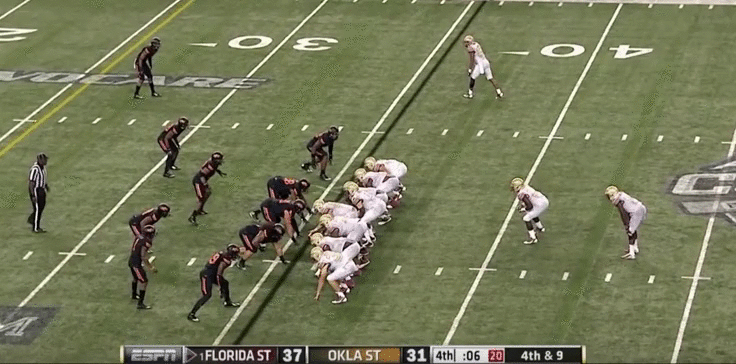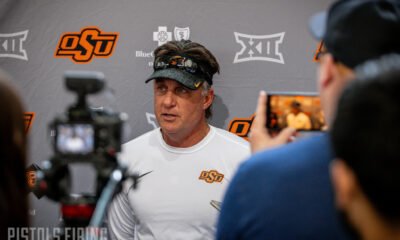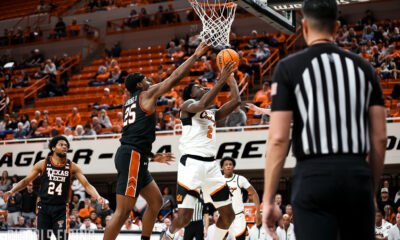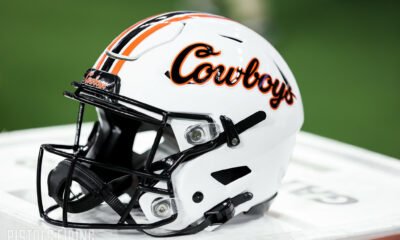Football
Chalk Talk: How the Game Should Have Ended

The Oklahoma State Cowboys were victim to a horrendous officiating error in their 30-27 loss to Central Michigan, but there were plenty of other ways to run out the clock and avoid the situation entirely. If the Cowboys insist on going the non-traditional route in their late-game run-out-the-clock situations, here are two ways they should keep in mind for next time.
In the Cowboys’ loss against Florida State in the 2014 season opener, Jameis Winston chunked the ball into the end zone on fourth down to expire the clock. The only difference between that and Saturday? There was a receiver running a route, although to say he was the ‘intended receiver’ is a bit of a stretch considering Winston chunked it straight to the goal posts. If just one receiver had been running a route, Rudolph could throw ahead of him by 15 yards and the game would end without penalty.

In the 2011 OSU-Texas A&M game, Justin Blackmon took the snap from a victory formation and ran backward for a safety. The situation was very similar to Saturday. It was fourth down, there were less than 10 seconds on the clock and the Cowboys were up by three points. But the Cowboys were actually at less of an advantage than they would have been running it against CMU. Not only was the ball in their own territory in this scenario (so there were less yards for Blackmon to run, therefore it would take a shorter amount of time) but also there was one more second on the clock than on Saturday’s. So if Rudolph (or whoever) would have just ran backward to the end zone, the clock would have easily expired in that time. And even if it didn’t, a well-executed squib on a safety punt is much easier to defend than a hail mary in a prevent defense.

Even if they didn’t take a safety or chunk the ball to expire the clock, they could have easily ran the ball. So why didn’t they?
When asked about hand-offs instead of kneeling to burn clock Gundy referenced the Herm Edwards fumble. That was in 1978! Scared straight.
— Carson Cunningham (@KOCOCarson) September 12, 2016
The thought that the threat of a fumble should deter a team from running the ball in an end-of-game situation is petty, especially considering that plenty of teams do that every week. And, even though we don’t have the full transcript of Gundy’s response, to not run the ball in fear due to one occurrence almost 40 years ago is absurd. Again, Gundy was probably not citing this example as the specific reason why they didn’t run the ball. But, without having the true numbers, the percentage of late-game fumbles in these situations are almost negligible, and it is (other than kneeling the ball) the safest option.
And even if they did take a knee on three downs, they could have easily punted the ball high and out of bounds or tried to pin the Chippewas deep in their own end zone, as sophomore punter Zach Sinor has become an expert on topper/backspin punts. A hail mary from deep inside a team’s own end zone, or even on the 25-yard line, is almost impossible to convert considering the distance from the end zone.
At the end of the day, this is all Captain Hindsight talk. Yes, they should have been smarter in the final seconds, but it’s already done. So let’s just hope this is a learning lesson for the next time a crucial late-game situation comes around.

-

 Hoops4 days ago
Hoops4 days agoFIU Transfer Arturo Dean Commits to Oklahoma State
-

 Football4 days ago
Football4 days agoThe Top 5 Quotes from Mike Gundy’s Final Spring Practice News Conference
-

 Hoops2 days ago
Hoops2 days agoTexas Tech Transfer Robert Jennings Commits to Oklahoma State
-

 Football5 days ago
Football5 days agoDefensive Line Prospect Xavier Ukponu Lists Oklahoma State in Top Group






